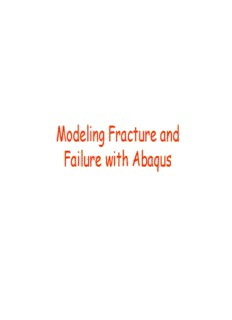
Modeling Fracture and Failure with Abaqus - iut.ac.ir PDF
Preview Modeling Fracture and Failure with Abaqus - iut.ac.ir
Modeling Fracture and Failure with Abaqus Damage and failure for ductile metals Introduction Fracture and failure modeling allows for product designs that maximize the safe operating life of structural components. Abaqus offers many capabilities that enable fracture and failure modeling. Damage and failure for ductile metals Introduction • Proper modeling techniques for capturing crack-tip singularities in fracture mechanics problems • Proper modeling techniques for finite-strain (nonlinear) fracture mechanics problems • Using Abaqus/CAE to create meshes appropriate for fracture studies • Calculation of stress intensity factors and contour integrals around a crack tip • Material damage and failure models • Wear and erosion modeling • Simulating crack growth using cohesive elements • Simulating crack growth using VCCT for Abaqus Fracture mechanics: overview ABAQUS/Standard provides the following methods for performing fracture mechanics studies: • Onset of cracking: The onset of cracking can be studied in quasi-static problems by using contour integrals. The J- integral, the C -integral (for creep), the stress intensity t factors for both homogeneous materials and interfacial cracks, the crack propagation direction, and the T-stress are calculated by ABAQUS/Standard. Contour integrals can be used in two- or three-dimensional problems. In these types of problems focused meshes are generally required and the propagation of a crack is not studied. Fracture mechanics: overview • Crack propagation: The crack propagation capability allows quasi-static crack growth along predefined paths to be studied in two-dimensional cases. Cracks debond along user-defined surfaces. Three crack propagation criteria are available, and multiple cracks can be included in the analysis. Contour integrals can be requested in crack propagation problems. • Line spring elements: Part-through cracks in shells can be modeled inexpensively by using line spring elements in a static procedure. Contour integral evaluation Abaqus/Standard offers the evaluation of several parameters for fracture mechanics studies: • the J-integral, which is widely accepted as a quasi-static fracture mechanics parameter for linear material response and, with limitations, for nonlinear material response; • the C -integral, which has an equivalent role to the J-integral t in the context of time-dependent creep behavior in a quasi- static step. • the stress intensity factors, which are used in linear elastic fracture mechanics to measure the strength of the local crack-tip fields. Contour integral evaluation • the crack propagation direction-i.e., the angle at which a preexisting crack will propagate. • the T-stress, which represents a stress parallel to the crack faces and is used as an indicator of the extent to which parameters like the J-integral are useful characterizations of the deformation field around the crack. Abaqus/CAE U Interaction module: Special Crack Create: Name: crack name sage: Step module: history output request editor: Domain: Contour integral name: crack name, Number of contours: n, Type: integral_type Contour integral evaluation • the crack propagation direction-i.e., the angle at which a preexisting crack will propagate. • the T-stress, which represents a stress parallel to the crack faces and is used as an indicator of the extent to which parameters like the J-integral are useful characterizations of the deformation field around the crack. Abaqus/CAE Interaction module: Special Crack Create: Name: crack name Usage: Step module: history output request editor: Domain: Contour integral name: crack name, Number of contours: n, Type: integral_type Defining the data required for a contour integral Defining the crack front: Abaqus/CAE Interaction module: Special Crack Create: select the crack front, then select the crack tip (in two dimensions) or crack line (in three Usage: dimensions) Abaqus/CAE Interaction module: Special Crack Create: select the crack front: Specify crack extension direction using: q vectors Usage: Defining the data required for a contour integral Defining the crack front:
Description: